CDU Project Proposal: E-Waste Recycling Business Case & Feasibility
VerifiedAdded on 2023/04/11
|17
|2522
|314
Project
AI Summary
This document presents a project proposal for establishing an e-waste recycling plant, funded by Charles Darwin University with a budget of $50,000 and a timeline of one year. The project aims to address the growing global issue of electronic waste by recycling obsolete electronics into valuable materials like plastics, metals, and glass. It outlines the project's objectives, management approach using the traditional waterfall method, and measures for success, including schedule adherence, product quality, and cost management. The proposal includes a SWOT analysis, quantitative analysis with payback period calculation, project requirements, potential risks, and associated mitigation strategies. The project aims to create a sustainable business model that benefits the community by reducing environmental pollution and generating economic value from e-waste.

1
Name:
Course
Professor’s name
University name
City, State
Date of submission
Name:
Course
Professor’s name
University name
City, State
Date of submission
Paraphrase This Document
Need a fresh take? Get an instant paraphrase of this document with our AI Paraphraser
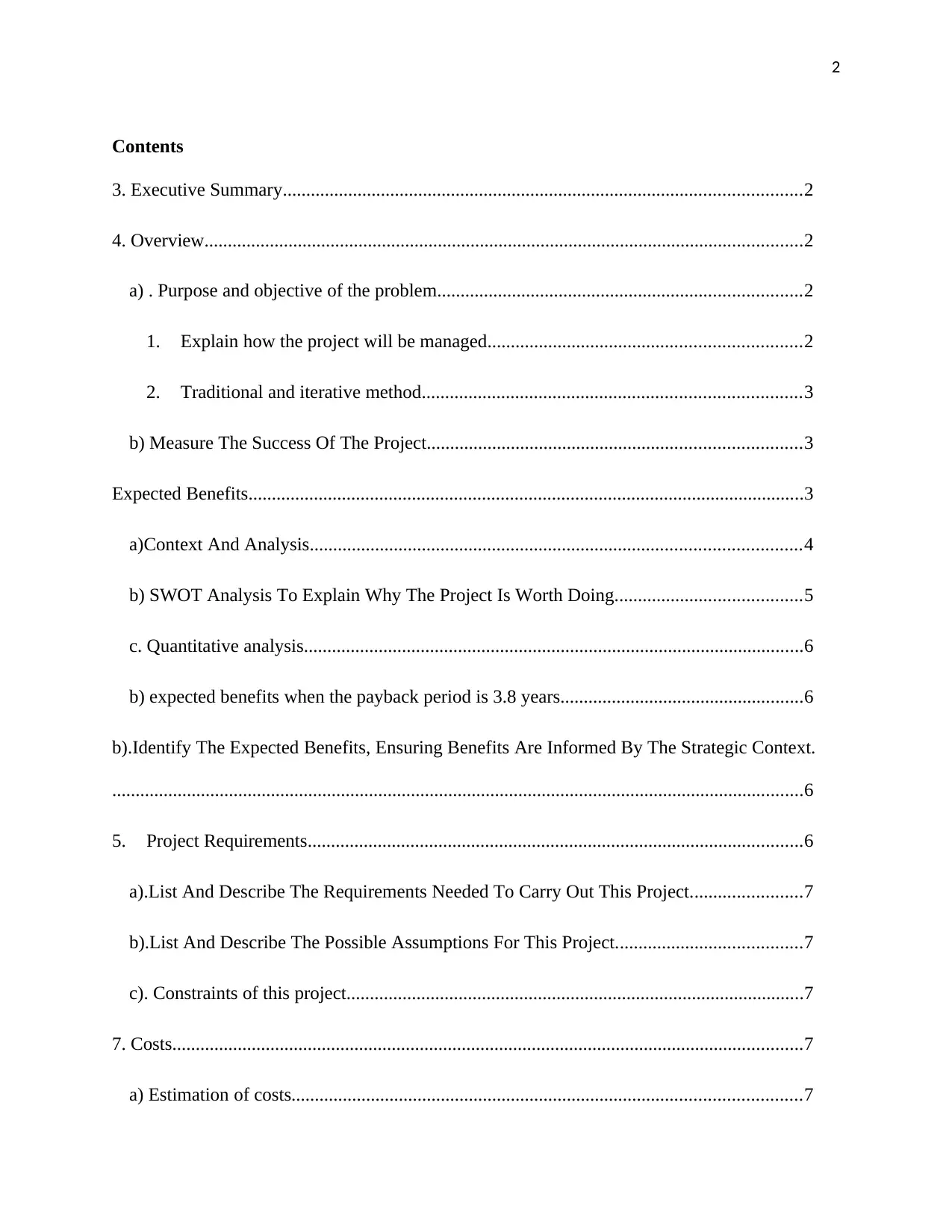
2
Contents
3. Executive Summary...............................................................................................................2
4. Overview................................................................................................................................2
a) . Purpose and objective of the problem..............................................................................2
1. Explain how the project will be managed...................................................................2
2. Traditional and iterative method.................................................................................3
b) Measure The Success Of The Project................................................................................3
Expected Benefits.......................................................................................................................3
a)Context And Analysis.........................................................................................................4
b) SWOT Analysis To Explain Why The Project Is Worth Doing........................................5
c. Quantitative analysis...........................................................................................................6
b) expected benefits when the payback period is 3.8 years....................................................6
b).Identify The Expected Benefits, Ensuring Benefits Are Informed By The Strategic Context.
....................................................................................................................................................6
5. Project Requirements..........................................................................................................6
a).List And Describe The Requirements Needed To Carry Out This Project........................7
b).List And Describe The Possible Assumptions For This Project........................................7
c). Constraints of this project..................................................................................................7
7. Costs.......................................................................................................................................7
a) Estimation of costs.............................................................................................................7
Contents
3. Executive Summary...............................................................................................................2
4. Overview................................................................................................................................2
a) . Purpose and objective of the problem..............................................................................2
1. Explain how the project will be managed...................................................................2
2. Traditional and iterative method.................................................................................3
b) Measure The Success Of The Project................................................................................3
Expected Benefits.......................................................................................................................3
a)Context And Analysis.........................................................................................................4
b) SWOT Analysis To Explain Why The Project Is Worth Doing........................................5
c. Quantitative analysis...........................................................................................................6
b) expected benefits when the payback period is 3.8 years....................................................6
b).Identify The Expected Benefits, Ensuring Benefits Are Informed By The Strategic Context.
....................................................................................................................................................6
5. Project Requirements..........................................................................................................6
a).List And Describe The Requirements Needed To Carry Out This Project........................7
b).List And Describe The Possible Assumptions For This Project........................................7
c). Constraints of this project..................................................................................................7
7. Costs.......................................................................................................................................7
a) Estimation of costs.............................................................................................................7
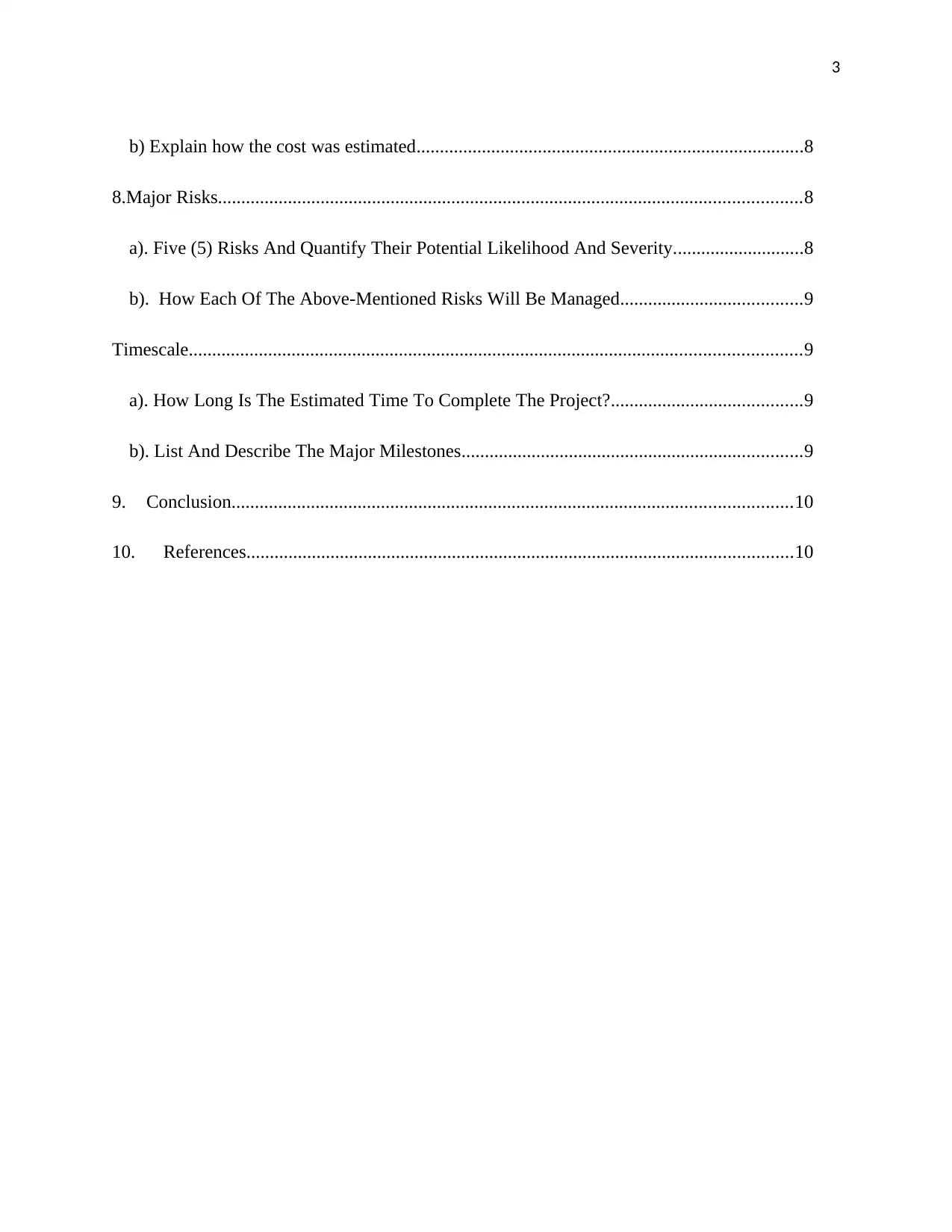
3
b) Explain how the cost was estimated...................................................................................8
8.Major Risks.............................................................................................................................8
a). Five (5) Risks And Quantify Their Potential Likelihood And Severity............................8
b). How Each Of The Above-Mentioned Risks Will Be Managed.......................................9
Timescale...................................................................................................................................9
a). How Long Is The Estimated Time To Complete The Project?.........................................9
b). List And Describe The Major Milestones.........................................................................9
9. Conclusion........................................................................................................................10
10. References.....................................................................................................................10
b) Explain how the cost was estimated...................................................................................8
8.Major Risks.............................................................................................................................8
a). Five (5) Risks And Quantify Their Potential Likelihood And Severity............................8
b). How Each Of The Above-Mentioned Risks Will Be Managed.......................................9
Timescale...................................................................................................................................9
a). How Long Is The Estimated Time To Complete The Project?.........................................9
b). List And Describe The Major Milestones.........................................................................9
9. Conclusion........................................................................................................................10
10. References.....................................................................................................................10
⊘ This is a preview!⊘
Do you want full access?
Subscribe today to unlock all pages.

Trusted by 1+ million students worldwide
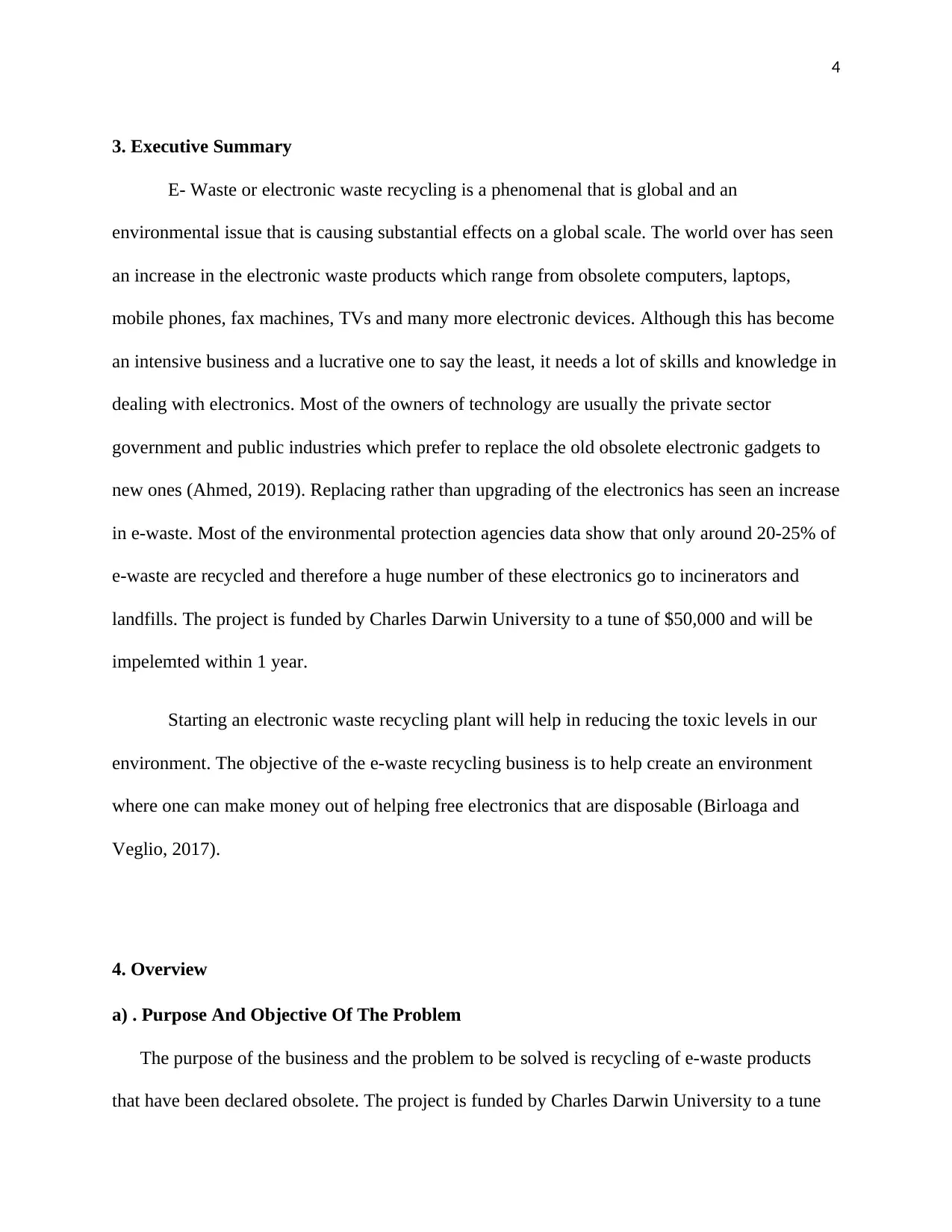
4
3. Executive Summary
E- Waste or electronic waste recycling is a phenomenal that is global and an
environmental issue that is causing substantial effects on a global scale. The world over has seen
an increase in the electronic waste products which range from obsolete computers, laptops,
mobile phones, fax machines, TVs and many more electronic devices. Although this has become
an intensive business and a lucrative one to say the least, it needs a lot of skills and knowledge in
dealing with electronics. Most of the owners of technology are usually the private sector
government and public industries which prefer to replace the old obsolete electronic gadgets to
new ones (Ahmed, 2019). Replacing rather than upgrading of the electronics has seen an increase
in e-waste. Most of the environmental protection agencies data show that only around 20-25% of
e-waste are recycled and therefore a huge number of these electronics go to incinerators and
landfills. The project is funded by Charles Darwin University to a tune of $50,000 and will be
impelemted within 1 year.
Starting an electronic waste recycling plant will help in reducing the toxic levels in our
environment. The objective of the e-waste recycling business is to help create an environment
where one can make money out of helping free electronics that are disposable (Birloaga and
Veglio, 2017).
4. Overview
a) . Purpose And Objective Of The Problem
The purpose of the business and the problem to be solved is recycling of e-waste products
that have been declared obsolete. The project is funded by Charles Darwin University to a tune
3. Executive Summary
E- Waste or electronic waste recycling is a phenomenal that is global and an
environmental issue that is causing substantial effects on a global scale. The world over has seen
an increase in the electronic waste products which range from obsolete computers, laptops,
mobile phones, fax machines, TVs and many more electronic devices. Although this has become
an intensive business and a lucrative one to say the least, it needs a lot of skills and knowledge in
dealing with electronics. Most of the owners of technology are usually the private sector
government and public industries which prefer to replace the old obsolete electronic gadgets to
new ones (Ahmed, 2019). Replacing rather than upgrading of the electronics has seen an increase
in e-waste. Most of the environmental protection agencies data show that only around 20-25% of
e-waste are recycled and therefore a huge number of these electronics go to incinerators and
landfills. The project is funded by Charles Darwin University to a tune of $50,000 and will be
impelemted within 1 year.
Starting an electronic waste recycling plant will help in reducing the toxic levels in our
environment. The objective of the e-waste recycling business is to help create an environment
where one can make money out of helping free electronics that are disposable (Birloaga and
Veglio, 2017).
4. Overview
a) . Purpose And Objective Of The Problem
The purpose of the business and the problem to be solved is recycling of e-waste products
that have been declared obsolete. The project is funded by Charles Darwin University to a tune
Paraphrase This Document
Need a fresh take? Get an instant paraphrase of this document with our AI Paraphraser
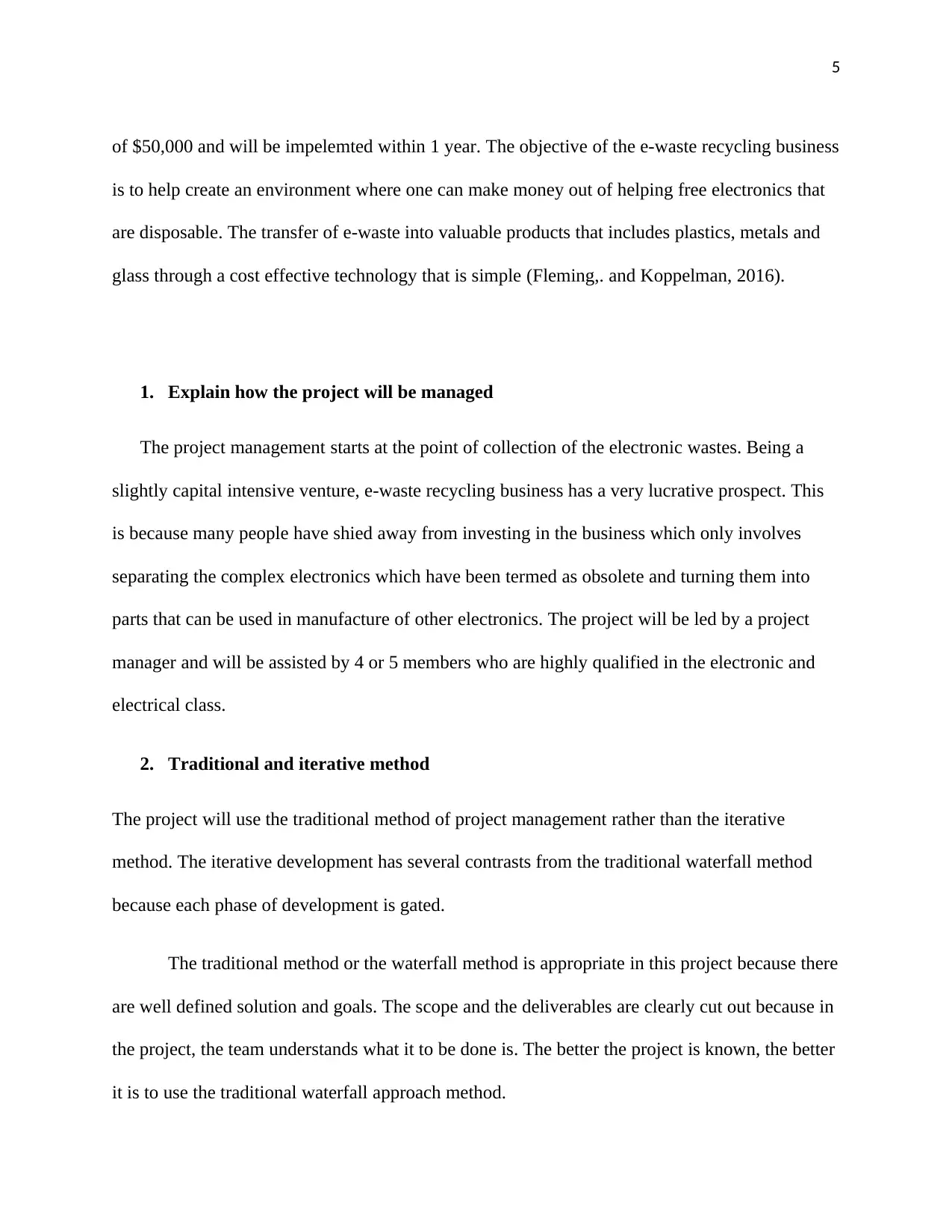
5
of $50,000 and will be impelemted within 1 year. The objective of the e-waste recycling business
is to help create an environment where one can make money out of helping free electronics that
are disposable. The transfer of e-waste into valuable products that includes plastics, metals and
glass through a cost effective technology that is simple (Fleming,. and Koppelman, 2016).
1. Explain how the project will be managed
The project management starts at the point of collection of the electronic wastes. Being a
slightly capital intensive venture, e-waste recycling business has a very lucrative prospect. This
is because many people have shied away from investing in the business which only involves
separating the complex electronics which have been termed as obsolete and turning them into
parts that can be used in manufacture of other electronics. The project will be led by a project
manager and will be assisted by 4 or 5 members who are highly qualified in the electronic and
electrical class.
2. Traditional and iterative method
The project will use the traditional method of project management rather than the iterative
method. The iterative development has several contrasts from the traditional waterfall method
because each phase of development is gated.
The traditional method or the waterfall method is appropriate in this project because there
are well defined solution and goals. The scope and the deliverables are clearly cut out because in
the project, the team understands what it to be done is. The better the project is known, the better
it is to use the traditional waterfall approach method.
of $50,000 and will be impelemted within 1 year. The objective of the e-waste recycling business
is to help create an environment where one can make money out of helping free electronics that
are disposable. The transfer of e-waste into valuable products that includes plastics, metals and
glass through a cost effective technology that is simple (Fleming,. and Koppelman, 2016).
1. Explain how the project will be managed
The project management starts at the point of collection of the electronic wastes. Being a
slightly capital intensive venture, e-waste recycling business has a very lucrative prospect. This
is because many people have shied away from investing in the business which only involves
separating the complex electronics which have been termed as obsolete and turning them into
parts that can be used in manufacture of other electronics. The project will be led by a project
manager and will be assisted by 4 or 5 members who are highly qualified in the electronic and
electrical class.
2. Traditional and iterative method
The project will use the traditional method of project management rather than the iterative
method. The iterative development has several contrasts from the traditional waterfall method
because each phase of development is gated.
The traditional method or the waterfall method is appropriate in this project because there
are well defined solution and goals. The scope and the deliverables are clearly cut out because in
the project, the team understands what it to be done is. The better the project is known, the better
it is to use the traditional waterfall approach method.
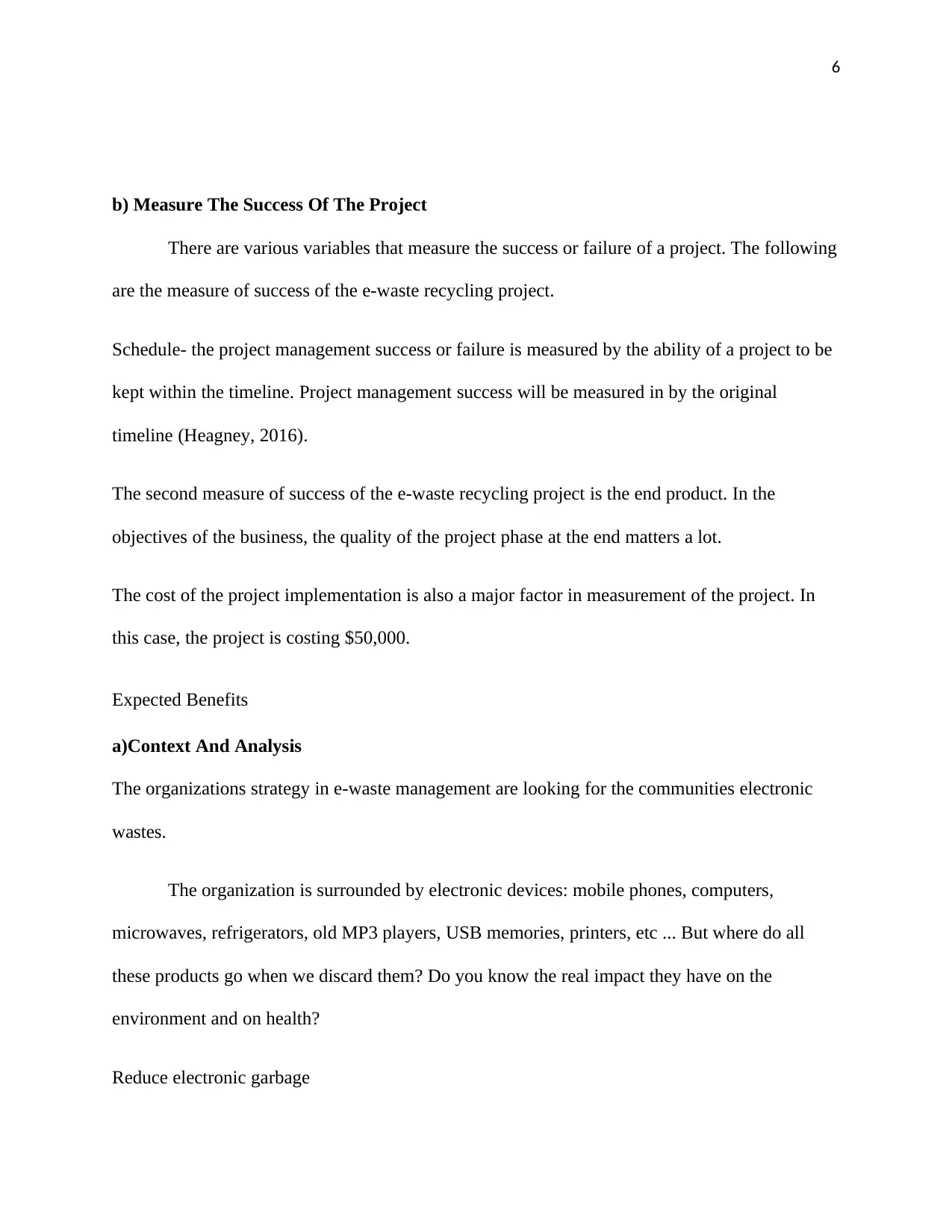
6
b) Measure The Success Of The Project
There are various variables that measure the success or failure of a project. The following
are the measure of success of the e-waste recycling project.
Schedule- the project management success or failure is measured by the ability of a project to be
kept within the timeline. Project management success will be measured in by the original
timeline (Heagney, 2016).
The second measure of success of the e-waste recycling project is the end product. In the
objectives of the business, the quality of the project phase at the end matters a lot.
The cost of the project implementation is also a major factor in measurement of the project. In
this case, the project is costing $50,000.
Expected Benefits
a)Context And Analysis
The organizations strategy in e-waste management are looking for the communities electronic
wastes.
The organization is surrounded by electronic devices: mobile phones, computers,
microwaves, refrigerators, old MP3 players, USB memories, printers, etc ... But where do all
these products go when we discard them? Do you know the real impact they have on the
environment and on health?
Reduce electronic garbage
b) Measure The Success Of The Project
There are various variables that measure the success or failure of a project. The following
are the measure of success of the e-waste recycling project.
Schedule- the project management success or failure is measured by the ability of a project to be
kept within the timeline. Project management success will be measured in by the original
timeline (Heagney, 2016).
The second measure of success of the e-waste recycling project is the end product. In the
objectives of the business, the quality of the project phase at the end matters a lot.
The cost of the project implementation is also a major factor in measurement of the project. In
this case, the project is costing $50,000.
Expected Benefits
a)Context And Analysis
The organizations strategy in e-waste management are looking for the communities electronic
wastes.
The organization is surrounded by electronic devices: mobile phones, computers,
microwaves, refrigerators, old MP3 players, USB memories, printers, etc ... But where do all
these products go when we discard them? Do you know the real impact they have on the
environment and on health?
Reduce electronic garbage
⊘ This is a preview!⊘
Do you want full access?
Subscribe today to unlock all pages.

Trusted by 1+ million students worldwide
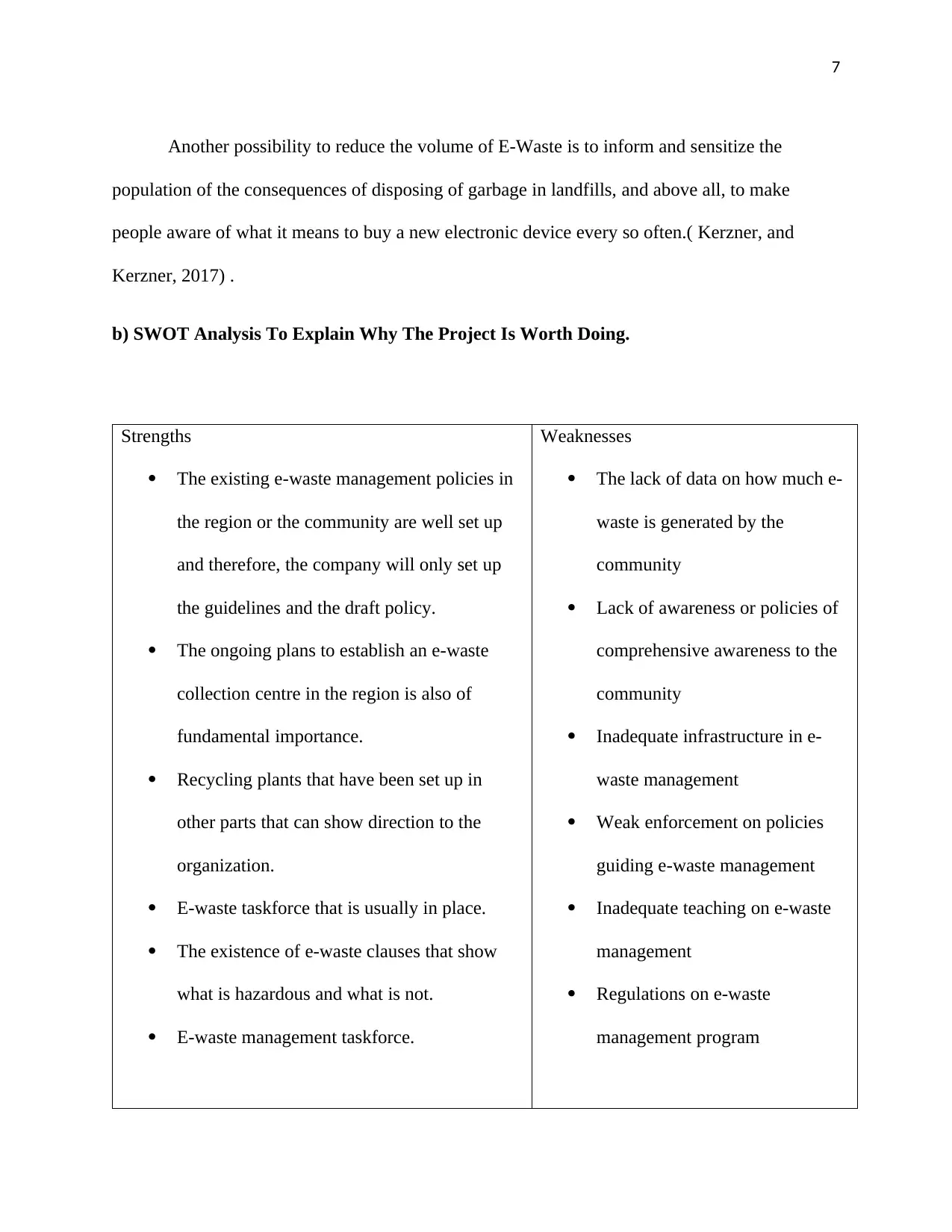
7
Another possibility to reduce the volume of E-Waste is to inform and sensitize the
population of the consequences of disposing of garbage in landfills, and above all, to make
people aware of what it means to buy a new electronic device every so often.( Kerzner, and
Kerzner, 2017) .
b) SWOT Analysis To Explain Why The Project Is Worth Doing.
Strengths
The existing e-waste management policies in
the region or the community are well set up
and therefore, the company will only set up
the guidelines and the draft policy.
The ongoing plans to establish an e-waste
collection centre in the region is also of
fundamental importance.
Recycling plants that have been set up in
other parts that can show direction to the
organization.
E-waste taskforce that is usually in place.
The existence of e-waste clauses that show
what is hazardous and what is not.
E-waste management taskforce.
Weaknesses
The lack of data on how much e-
waste is generated by the
community
Lack of awareness or policies of
comprehensive awareness to the
community
Inadequate infrastructure in e-
waste management
Weak enforcement on policies
guiding e-waste management
Inadequate teaching on e-waste
management
Regulations on e-waste
management program
Another possibility to reduce the volume of E-Waste is to inform and sensitize the
population of the consequences of disposing of garbage in landfills, and above all, to make
people aware of what it means to buy a new electronic device every so often.( Kerzner, and
Kerzner, 2017) .
b) SWOT Analysis To Explain Why The Project Is Worth Doing.
Strengths
The existing e-waste management policies in
the region or the community are well set up
and therefore, the company will only set up
the guidelines and the draft policy.
The ongoing plans to establish an e-waste
collection centre in the region is also of
fundamental importance.
Recycling plants that have been set up in
other parts that can show direction to the
organization.
E-waste taskforce that is usually in place.
The existence of e-waste clauses that show
what is hazardous and what is not.
E-waste management taskforce.
Weaknesses
The lack of data on how much e-
waste is generated by the
community
Lack of awareness or policies of
comprehensive awareness to the
community
Inadequate infrastructure in e-
waste management
Weak enforcement on policies
guiding e-waste management
Inadequate teaching on e-waste
management
Regulations on e-waste
management program
Paraphrase This Document
Need a fresh take? Get an instant paraphrase of this document with our AI Paraphraser
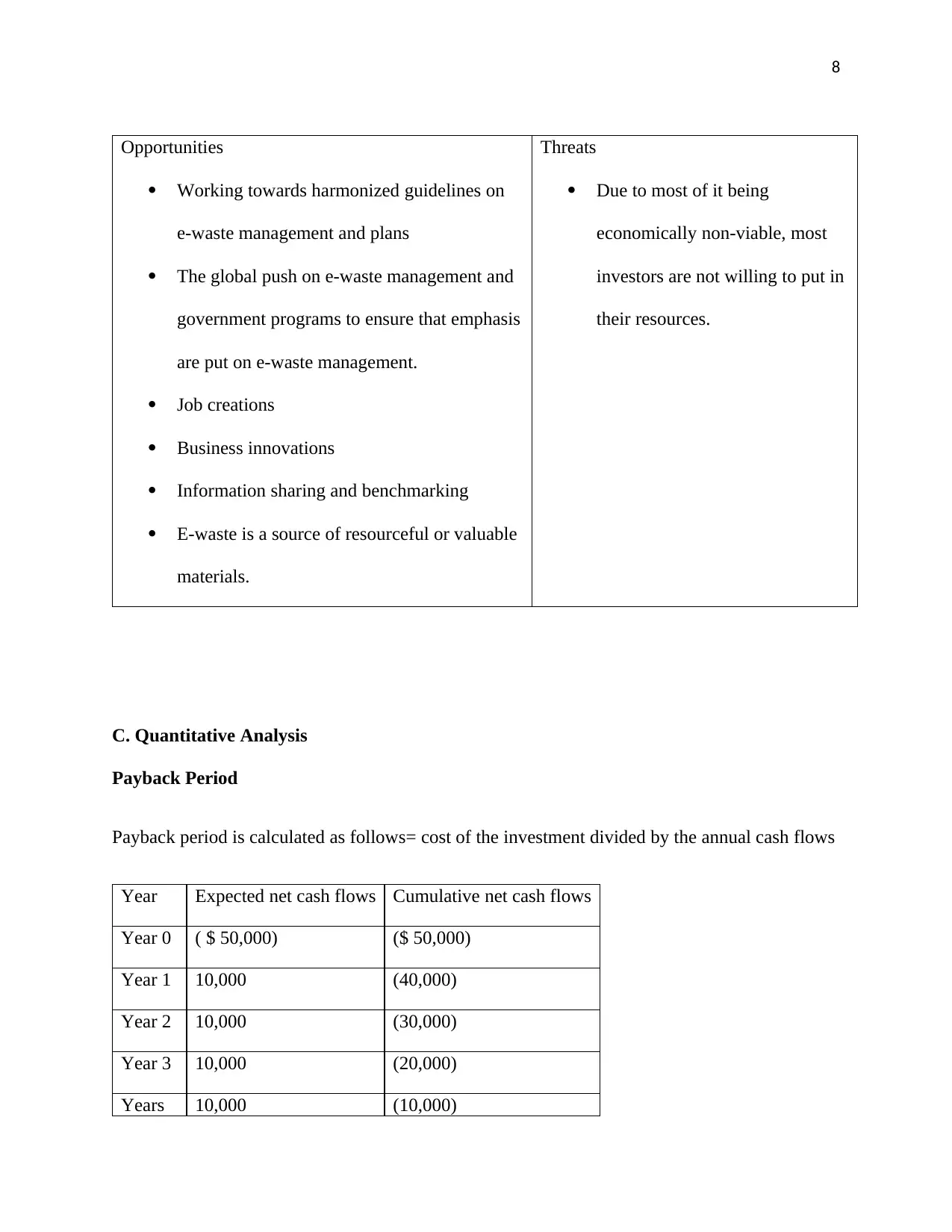
8
Opportunities
Working towards harmonized guidelines on
e-waste management and plans
The global push on e-waste management and
government programs to ensure that emphasis
are put on e-waste management.
Job creations
Business innovations
Information sharing and benchmarking
E-waste is a source of resourceful or valuable
materials.
Threats
Due to most of it being
economically non-viable, most
investors are not willing to put in
their resources.
C. Quantitative Analysis
Payback Period
Payback period is calculated as follows= cost of the investment divided by the annual cash flows
Year Expected net cash flows Cumulative net cash flows
Year 0 ( $ 50,000) ($ 50,000)
Year 1 10,000 (40,000)
Year 2 10,000 (30,000)
Year 3 10,000 (20,000)
Years 10,000 (10,000)
Opportunities
Working towards harmonized guidelines on
e-waste management and plans
The global push on e-waste management and
government programs to ensure that emphasis
are put on e-waste management.
Job creations
Business innovations
Information sharing and benchmarking
E-waste is a source of resourceful or valuable
materials.
Threats
Due to most of it being
economically non-viable, most
investors are not willing to put in
their resources.
C. Quantitative Analysis
Payback Period
Payback period is calculated as follows= cost of the investment divided by the annual cash flows
Year Expected net cash flows Cumulative net cash flows
Year 0 ( $ 50,000) ($ 50,000)
Year 1 10,000 (40,000)
Year 2 10,000 (30,000)
Year 3 10,000 (20,000)
Years 10,000 (10,000)
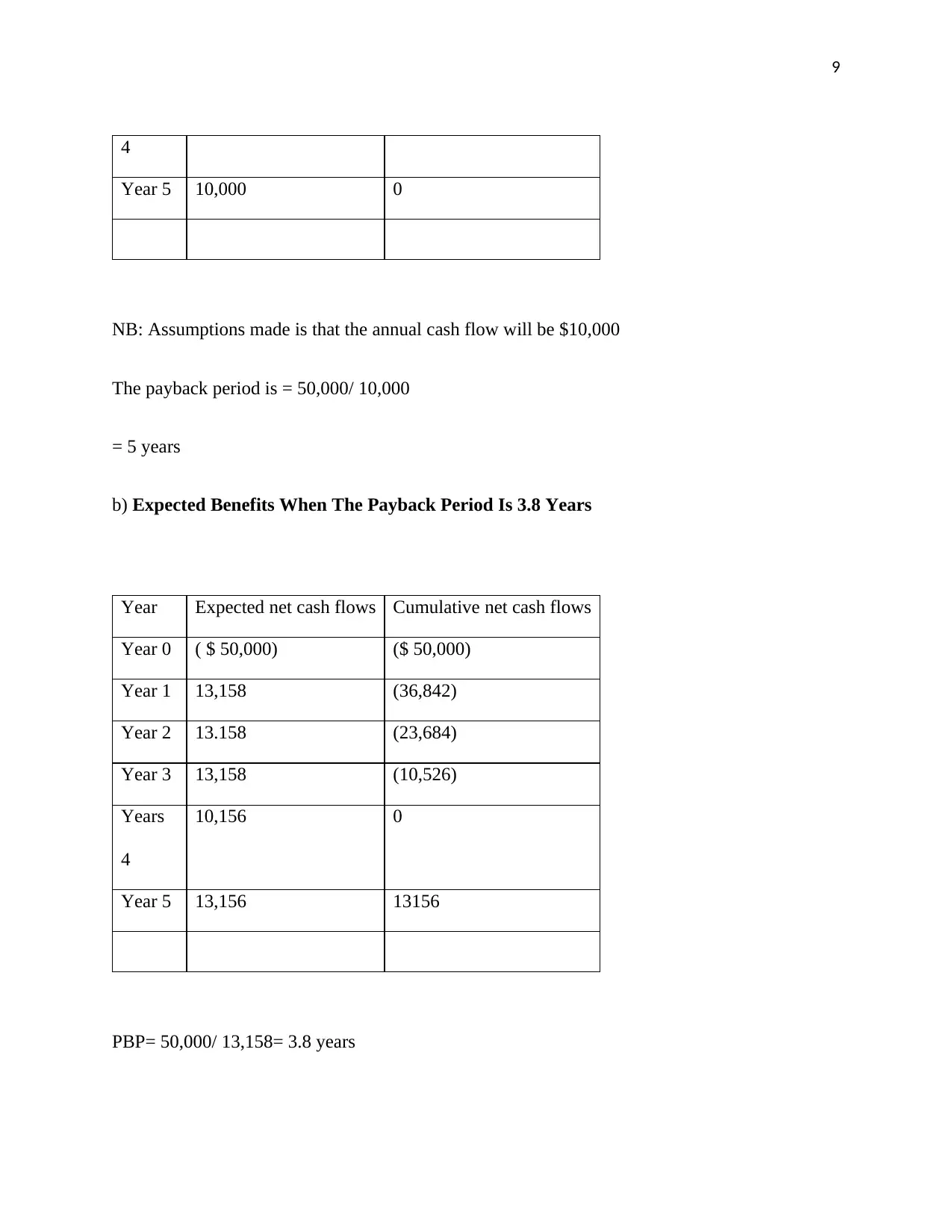
9
4
Year 5 10,000 0
NB: Assumptions made is that the annual cash flow will be $10,000
The payback period is = 50,000/ 10,000
= 5 years
b) Expected Benefits When The Payback Period Is 3.8 Years
Year Expected net cash flows Cumulative net cash flows
Year 0 ( $ 50,000) ($ 50,000)
Year 1 13,158 (36,842)
Year 2 13.158 (23,684)
Year 3 13,158 (10,526)
Years
4
10,156 0
Year 5 13,156 13156
PBP= 50,000/ 13,158= 3.8 years
4
Year 5 10,000 0
NB: Assumptions made is that the annual cash flow will be $10,000
The payback period is = 50,000/ 10,000
= 5 years
b) Expected Benefits When The Payback Period Is 3.8 Years
Year Expected net cash flows Cumulative net cash flows
Year 0 ( $ 50,000) ($ 50,000)
Year 1 13,158 (36,842)
Year 2 13.158 (23,684)
Year 3 13,158 (10,526)
Years
4
10,156 0
Year 5 13,156 13156
PBP= 50,000/ 13,158= 3.8 years
⊘ This is a preview!⊘
Do you want full access?
Subscribe today to unlock all pages.

Trusted by 1+ million students worldwide
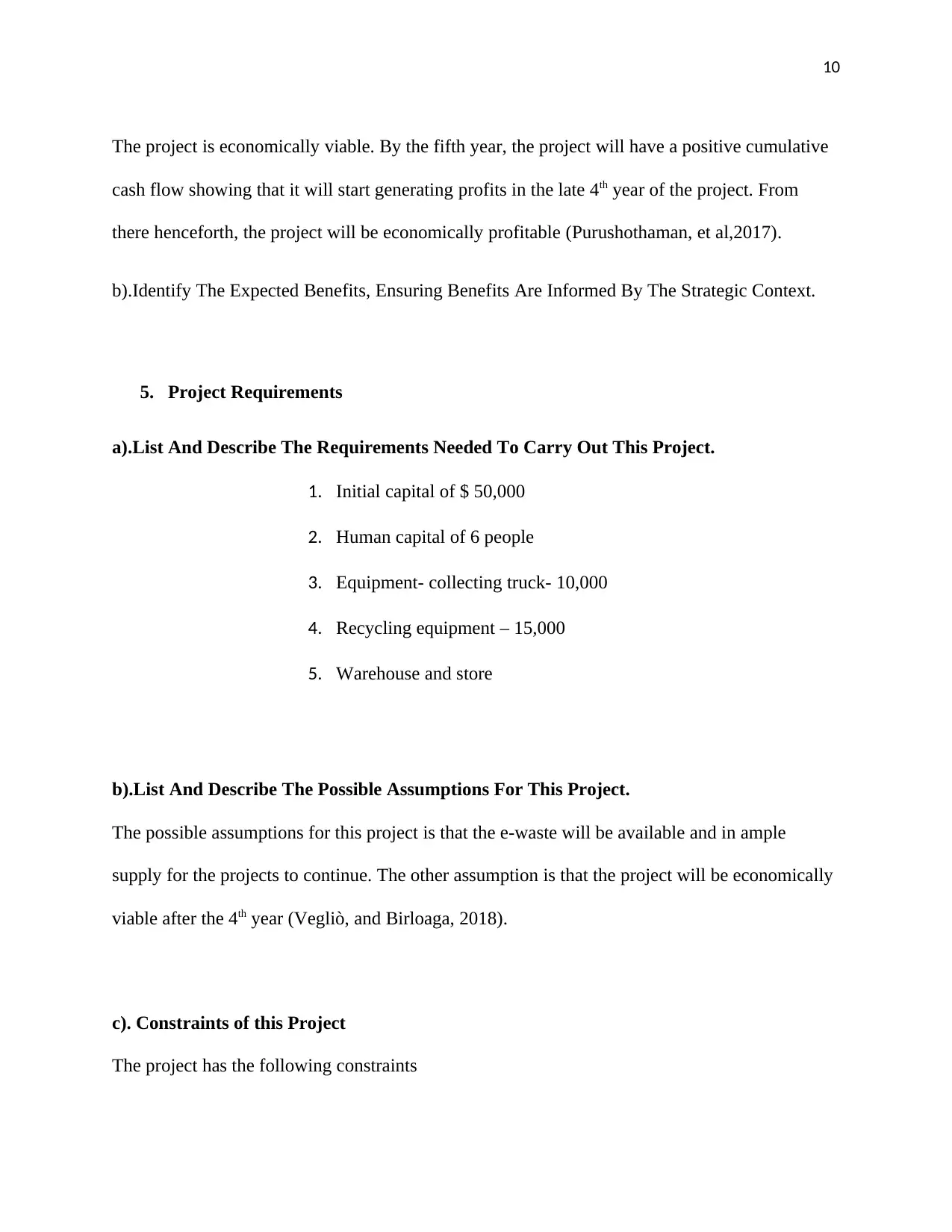
10
The project is economically viable. By the fifth year, the project will have a positive cumulative
cash flow showing that it will start generating profits in the late 4th year of the project. From
there henceforth, the project will be economically profitable (Purushothaman, et al,2017).
b).Identify The Expected Benefits, Ensuring Benefits Are Informed By The Strategic Context.
5. Project Requirements
a).List And Describe The Requirements Needed To Carry Out This Project.
1. Initial capital of $ 50,000
2. Human capital of 6 people
3. Equipment- collecting truck- 10,000
4. Recycling equipment – 15,000
5. Warehouse and store
b).List And Describe The Possible Assumptions For This Project.
The possible assumptions for this project is that the e-waste will be available and in ample
supply for the projects to continue. The other assumption is that the project will be economically
viable after the 4th year (Vegliò, and Birloaga, 2018).
c). Constraints of this Project
The project has the following constraints
The project is economically viable. By the fifth year, the project will have a positive cumulative
cash flow showing that it will start generating profits in the late 4th year of the project. From
there henceforth, the project will be economically profitable (Purushothaman, et al,2017).
b).Identify The Expected Benefits, Ensuring Benefits Are Informed By The Strategic Context.
5. Project Requirements
a).List And Describe The Requirements Needed To Carry Out This Project.
1. Initial capital of $ 50,000
2. Human capital of 6 people
3. Equipment- collecting truck- 10,000
4. Recycling equipment – 15,000
5. Warehouse and store
b).List And Describe The Possible Assumptions For This Project.
The possible assumptions for this project is that the e-waste will be available and in ample
supply for the projects to continue. The other assumption is that the project will be economically
viable after the 4th year (Vegliò, and Birloaga, 2018).
c). Constraints of this Project
The project has the following constraints
Paraphrase This Document
Need a fresh take? Get an instant paraphrase of this document with our AI Paraphraser
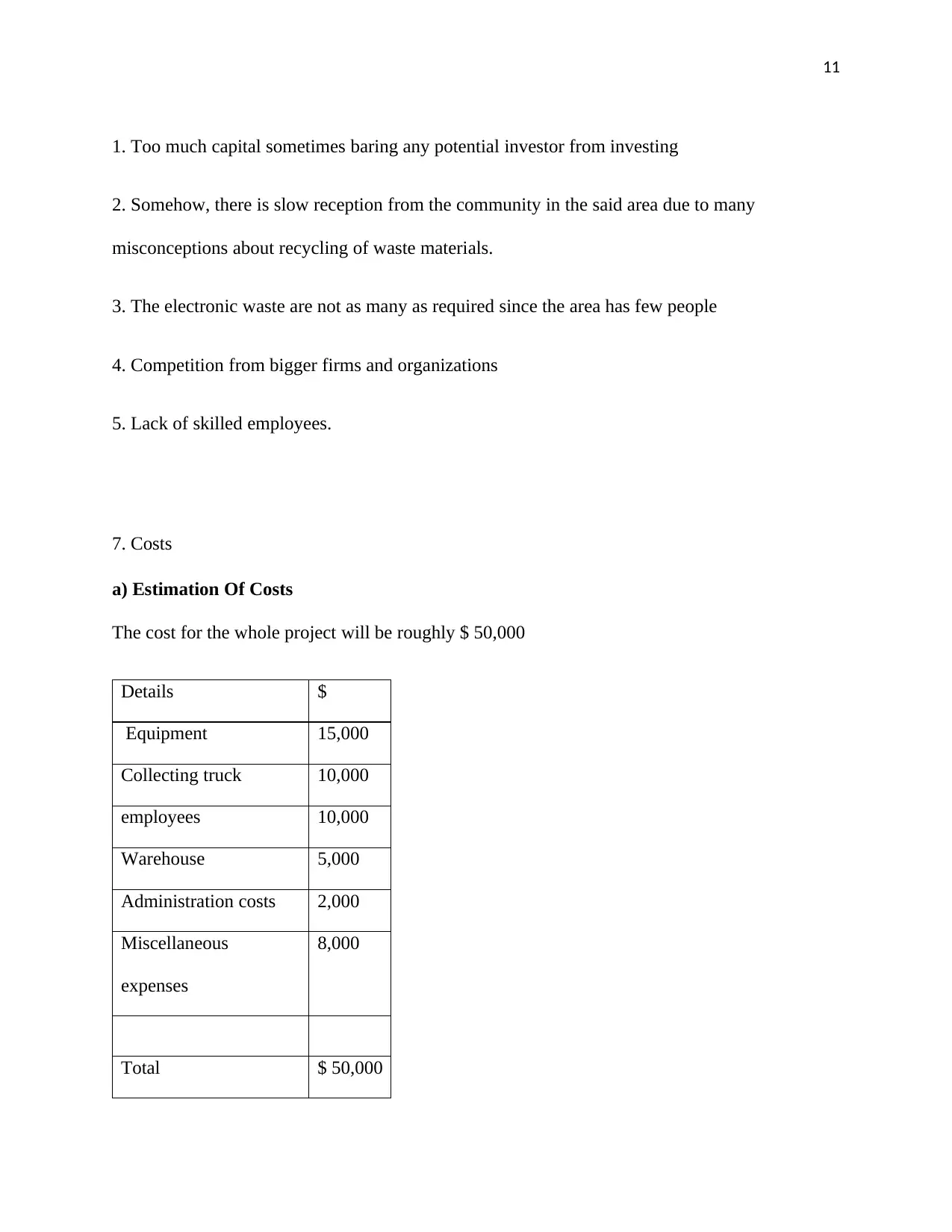
11
1. Too much capital sometimes baring any potential investor from investing
2. Somehow, there is slow reception from the community in the said area due to many
misconceptions about recycling of waste materials.
3. The electronic waste are not as many as required since the area has few people
4. Competition from bigger firms and organizations
5. Lack of skilled employees.
7. Costs
a) Estimation Of Costs
The cost for the whole project will be roughly $ 50,000
Details $
Equipment 15,000
Collecting truck 10,000
employees 10,000
Warehouse 5,000
Administration costs 2,000
Miscellaneous
expenses
8,000
Total $ 50,000
1. Too much capital sometimes baring any potential investor from investing
2. Somehow, there is slow reception from the community in the said area due to many
misconceptions about recycling of waste materials.
3. The electronic waste are not as many as required since the area has few people
4. Competition from bigger firms and organizations
5. Lack of skilled employees.
7. Costs
a) Estimation Of Costs
The cost for the whole project will be roughly $ 50,000
Details $
Equipment 15,000
Collecting truck 10,000
employees 10,000
Warehouse 5,000
Administration costs 2,000
Miscellaneous
expenses
8,000
Total $ 50,000
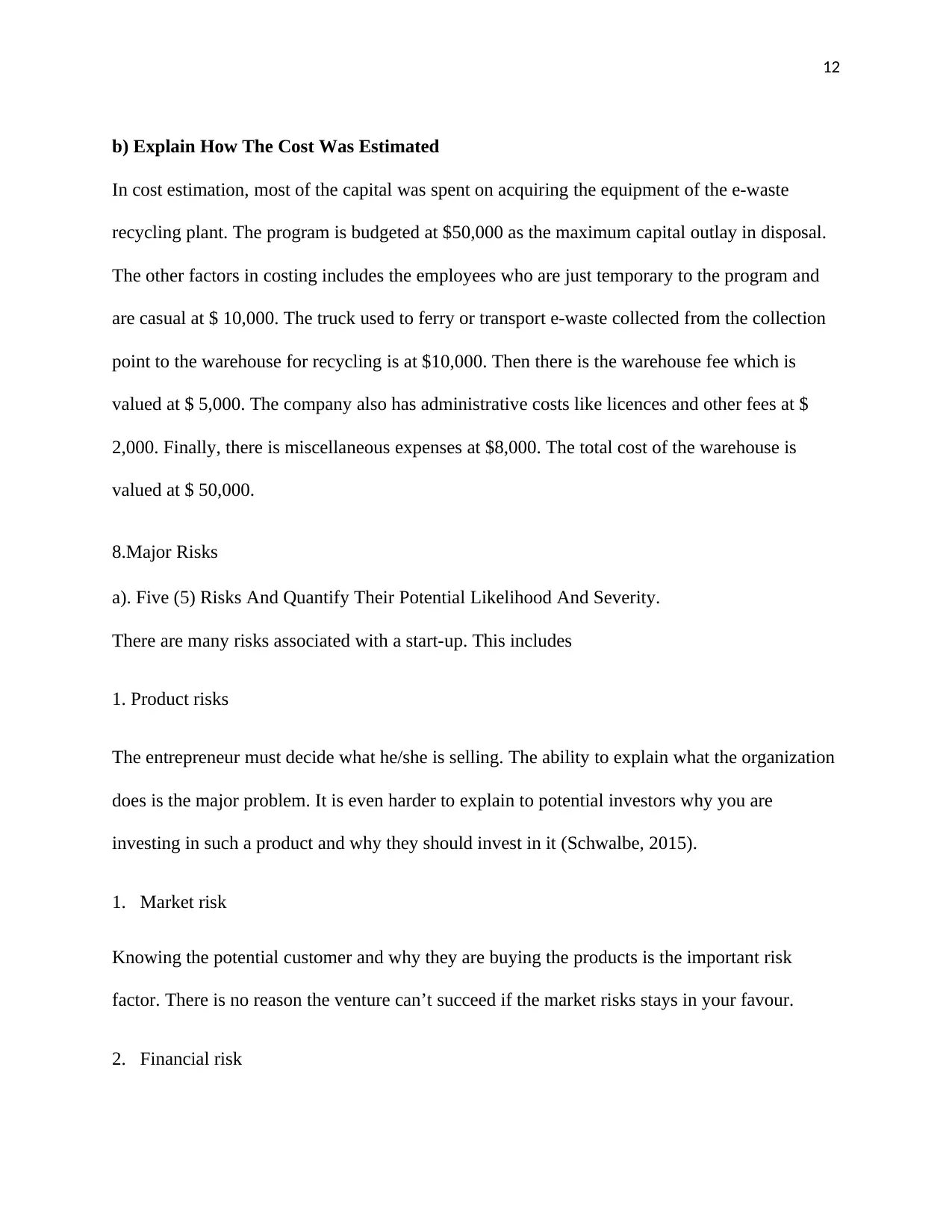
12
b) Explain How The Cost Was Estimated
In cost estimation, most of the capital was spent on acquiring the equipment of the e-waste
recycling plant. The program is budgeted at $50,000 as the maximum capital outlay in disposal.
The other factors in costing includes the employees who are just temporary to the program and
are casual at $ 10,000. The truck used to ferry or transport e-waste collected from the collection
point to the warehouse for recycling is at $10,000. Then there is the warehouse fee which is
valued at $ 5,000. The company also has administrative costs like licences and other fees at $
2,000. Finally, there is miscellaneous expenses at $8,000. The total cost of the warehouse is
valued at $ 50,000.
8.Major Risks
a). Five (5) Risks And Quantify Their Potential Likelihood And Severity.
There are many risks associated with a start-up. This includes
1. Product risks
The entrepreneur must decide what he/she is selling. The ability to explain what the organization
does is the major problem. It is even harder to explain to potential investors why you are
investing in such a product and why they should invest in it (Schwalbe, 2015).
1. Market risk
Knowing the potential customer and why they are buying the products is the important risk
factor. There is no reason the venture can’t succeed if the market risks stays in your favour.
2. Financial risk
b) Explain How The Cost Was Estimated
In cost estimation, most of the capital was spent on acquiring the equipment of the e-waste
recycling plant. The program is budgeted at $50,000 as the maximum capital outlay in disposal.
The other factors in costing includes the employees who are just temporary to the program and
are casual at $ 10,000. The truck used to ferry or transport e-waste collected from the collection
point to the warehouse for recycling is at $10,000. Then there is the warehouse fee which is
valued at $ 5,000. The company also has administrative costs like licences and other fees at $
2,000. Finally, there is miscellaneous expenses at $8,000. The total cost of the warehouse is
valued at $ 50,000.
8.Major Risks
a). Five (5) Risks And Quantify Their Potential Likelihood And Severity.
There are many risks associated with a start-up. This includes
1. Product risks
The entrepreneur must decide what he/she is selling. The ability to explain what the organization
does is the major problem. It is even harder to explain to potential investors why you are
investing in such a product and why they should invest in it (Schwalbe, 2015).
1. Market risk
Knowing the potential customer and why they are buying the products is the important risk
factor. There is no reason the venture can’t succeed if the market risks stays in your favour.
2. Financial risk
⊘ This is a preview!⊘
Do you want full access?
Subscribe today to unlock all pages.

Trusted by 1+ million students worldwide
1 out of 17
Related Documents
Your All-in-One AI-Powered Toolkit for Academic Success.
+13062052269
info@desklib.com
Available 24*7 on WhatsApp / Email
![[object Object]](/_next/static/media/star-bottom.7253800d.svg)
Unlock your academic potential
Copyright © 2020–2025 A2Z Services. All Rights Reserved. Developed and managed by ZUCOL.





